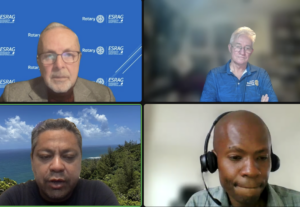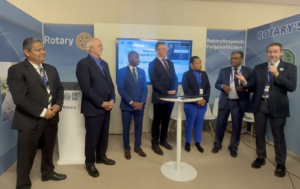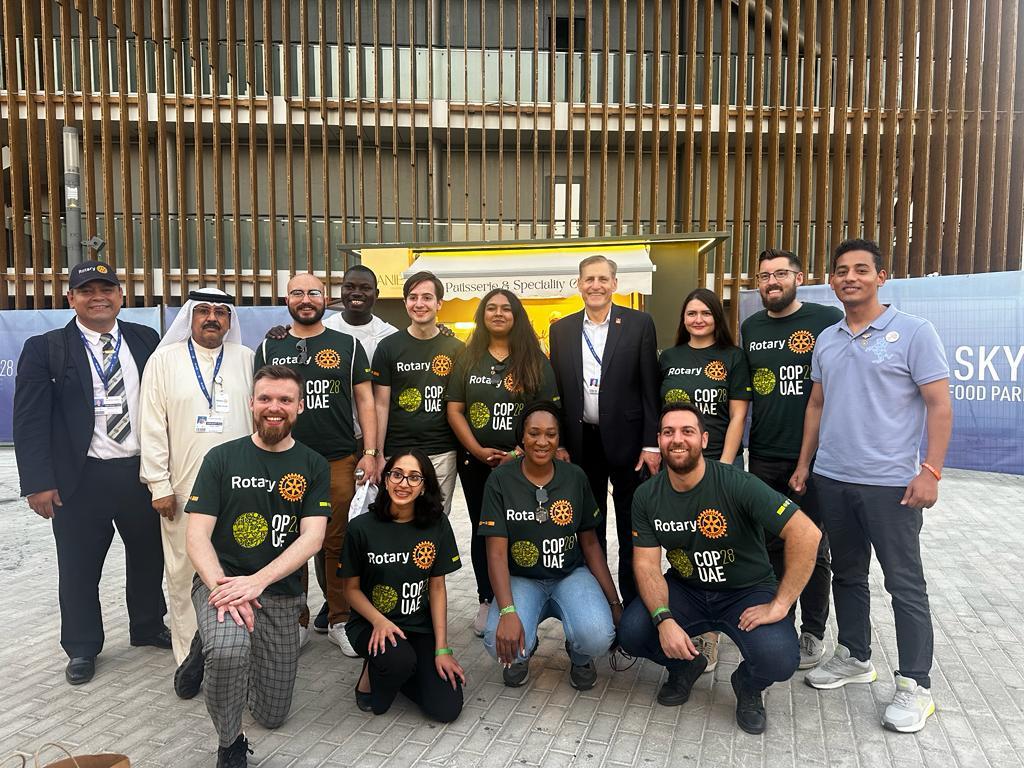By Ariel Miller, ESRAG Newsletter Editor

ESRAG leaders reporting on COP 28 during their Dec. 20 webinar. From top left, clockwise: ESRAG Chair Dr. Yasar Atacik, Past Chair Dr. Chris Puttock, Director Felix Kimani Kariuki, and Adopt-a-River champion Salvador Rico.
Rotary’s dramatically increased participation in the 2023 UN Climate Conference (COP 28) opened major opportunities for Rotarians to help accelerate global action on the climate crisis. In their Dec. 20 ESRAG webinar, ESRAG leaders who attended COP 28 put the spotlight on climate goals that Rotary is well-positioned to advance, including health, peace, renewable energy, regenerative agriculture, and food and water security.
Rotary sent its largest official delegation ever, including RI President Gordon McInally, Foundation Chair Barry Rassin, General Secretary and CEO John Hewko, and ESRAG Chair Yasar Atacik. Rotary’s International President Nominee Mario César Martins de Camargo also attended. In the Dec. 20 recap, Dr. Atacik and other ESRAG leaders referred to key COP 28 declarations and roadmaps which the Rotary family can draw on maximize our leverage. This article includes hyperlinks to the resources they shared.
“Unfortunately we are not on track to limit warming to 1.5 or even 2 degrees Celsius – things are much worse than that,” Dr. Atacik said. But RI has great potential as a humanitarian organization with members working at the local and regional level on six continents. He pinpointed several ways Rotarians can accelerate climate action:
- Adaptation – location-specific, sustainable food production and resilient water systems.
- Capacity-building, especially through working with municipalities.
- Mitigation – speeding the clean energy transition through our solar energy projects and ESRAG’s million solar panel campaign.

The Rotaractors chosen to represent RI at COP 28, with RI delegates Salvador Rico and John Hewko.
“This is the third time I’ve led Rotary’s delegation to the UN Climate Conference, and the first time we’ve had ten theme days covering every aspect from health to energy,” said Judith Diment, MBE, Dean of Rotary’s Representative Network, which connects RI to the major UN agencies. “It is very important to have all the Rotary Action Groups involved.” Fellow Rotary delegate Dr. Chris Puttock, past chair of ESRAG, chairs the Council of Rotary Action Groups.
For the first time ever, Rotary had its own pavilions at COP – one in the Blue Zone (COP’s official plenary and negotiation space) and the other in the Green Zone open to the public. These meeting spaces provided an unprecedented opportunity for Rotarians and Rotaractors with multiple kinds of expertise to negotiate with other stakeholders. “This was a wonderful opportunity for raising Rotary’s profile on the world stage,” said Judith Diment. “We are building partnerships with other agencies that clubs can work with.”
“Our presence at COP has really grown,” said Chris Puttock, who played a central role in organizing over 20 programs at Rotary’s COP 28 pavilions. Those pavilions gave Rotary and ESRAG leaders the opportunity to meet “so many Rotarians we didn’t previously know who were there.”
Resources, networking, and next steps: Despite the controversies and failures of the climate negotiations, members of the Rotary family emerged from COP 28 enormously energized. “We created five new partnerships through sponsors before the event,” reported Chris Puttock. “Judith Diment has a spreadsheet of major contacts including corporations we haven’t worked with before.” One of the sponsors is Sand Dams Worldwide, who provided an article for this issue of ERSAG’s newsletter.
“Rotaractors plan to keep meeting to reinforce what they discovered,” says Rob Sisson, a business sustainability consultant who is one of the twelve Rotaractors chosen to represent Rotary at COP 28. “Although governments haven’t been able to do much, other stakeholders are stepping up to change how capital is distributed. The impacts will be tremendous. In February, [the International Financial Reporting Standards Foundation will hold] a sustainability standards symposium in New York. Go!”
“COP 28 presented a road map to align food systems to climate solutions, to cut agricultural emissions 25% by 2030,” said ESRAG Director and agronomist Felix Kimani Kariuki, who attended from Kenya and is helping to organize ESRAG’s new task force on sustainable agriculture. He specifically mentioned the huge emissions caused by livestock.
Kariuki met at COP with leaders from several UN agencies, NGOs, and regional and national agricultural officials. He celebrates the Global Green Growth Institute’s $10 billion ground-breaking Africa and Middle East Safe Initiative, “whose Director and Head of Programs in Africa, Dr. Malle Fofana, I engaged. We need to build on the relationships we have started, and also get organizations, especially ministries of agriculture, to contribute to Rotary’s Zone Institutes.”

Rotary Foundation Chair Barry Rassin with American and Indian officials signing the River Cities Alliance at Rotary’s Blue Zone Pavilion
One of the exciting commitments formalized at COP 28 was the signing of the Memorandum of Common Purpose between the Mississippi River Cities and Towns Initiative and the India River Cities Alliance at Rotary’s Blue Zone Pavilion.
ESRAG leaders spotlighted several COP 28 documents – most of them succinct and packed with hyperlinks – as particularly useful to guide Rotary climate action. These include:
The Summary of Global Climate Action at COP 28, covering four pillars:
- Fast-tracking a just, orderly, and equitable energy transition
- Fixing climate finance
- Focusing on people, lives, and livelihoods
- Underpinning everything with gender equity and voice and leadership of youth, indigenous people, and people with disabilities.
The 2030 Climate Solutions: an Implementation Roadmap which the Summary of Global Climate Action describes as “a set of solutions framed in specific actions, with insights from a wide range of non-Party stakeholders on effective measures being undertaken that need to be scaled up and replicated as well as current gaps that need to be bridged to halve global emissions, address adaptation gaps and increase the resilience of four billion people from vulnerable groups and communities to climate risks by 2030.” This includes sections on energy, transport, land-use, ocean and coastal zones, and water.
The Call to Action for Transforming Food Systems for People, Nature, and Climate in which the UN Food and Agriculture Organization presents a global road map for eliminating hunger, with 120 actions and key milestones.
The 2023 Progress Report of the Race to Zero Campaign states that more than 13,500 Non-Party stakeholders are engaged in the campaign, almost twice as many as at COP 26 in 2021. Non-Party stakeholders include NGOs. “The Rotary Board is discussing the concept of commitment to Rotary’s becoming Net-Zero by 2040,” reported ESRAG Chair Yasar Atacick. “Pilot districts are likely – stay tuned.”
“It is very important that the COP process be reported to Rotary’s International Assembly,” said David Alexander, a Rotary District Governor Elect. “Also at Zone Institutes, where Presidents-Elect are trained. The time for sugar-coating the climate crisis is over.” Rotarian Salvador Rico, who also served on Rotary’s COP 28 delegation, responded that he is planning to give a talk on watershed projects at International Assembly.
Watch for more Rotary COP 28 participants on the opportunities for Rotarians to contribute to global climate action in upcoming ESRAG Projects + webinars, our News blog, and this newsletter.

